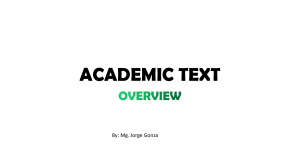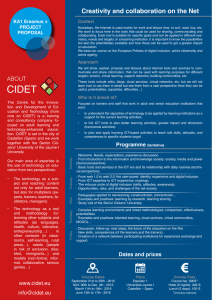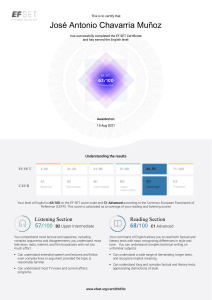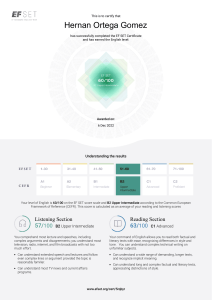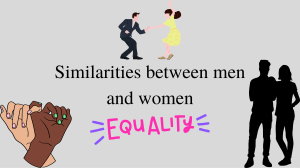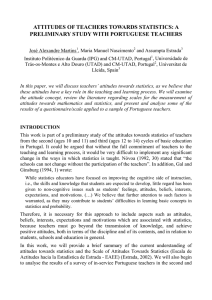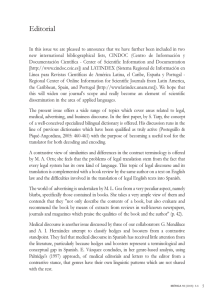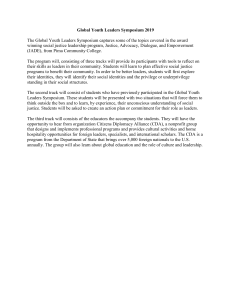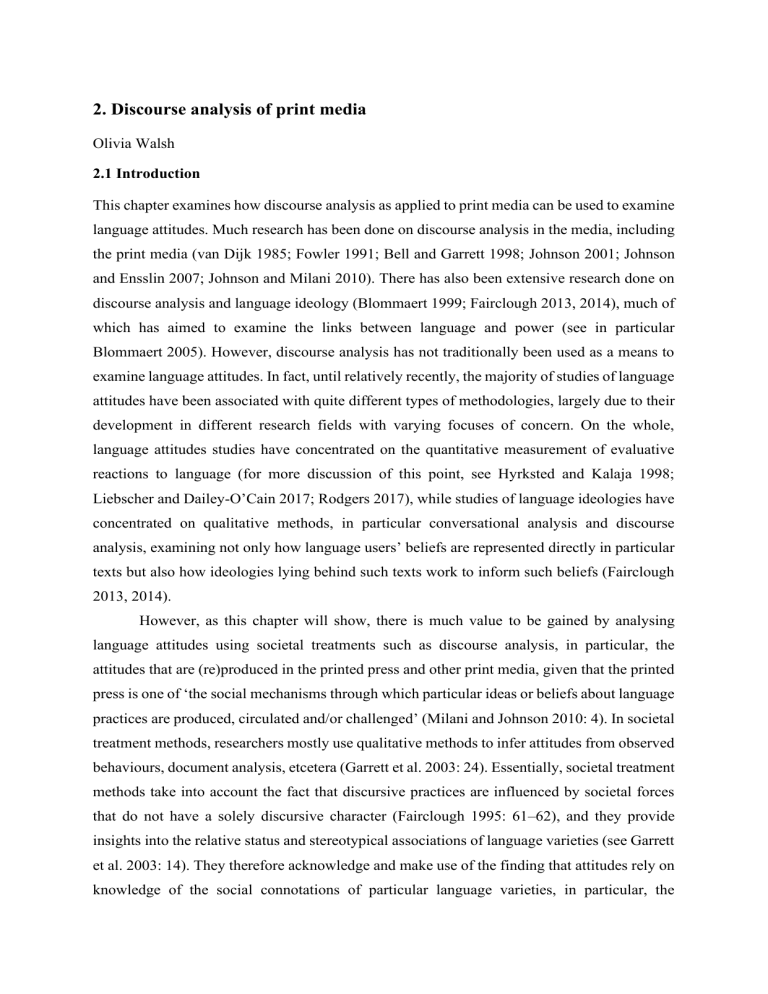
2. Discourse analysis of print media Olivia Walsh 2.1 Introduction This chapter examines how discourse analysis as applied to print media can be used to examine language attitudes. Much research has been done on discourse analysis in the media, including the print media (van Dijk 1985; Fowler 1991; Bell and Garrett 1998; Johnson 2001; Johnson and Ensslin 2007; Johnson and Milani 2010). There has also been extensive research done on discourse analysis and language ideology (Blommaert 1999; Fairclough 2013, 2014), much of which has aimed to examine the links between language and power (see in particular Blommaert 2005). However, discourse analysis has not traditionally been used as a means to examine language attitudes. In fact, until relatively recently, the majority of studies of language attitudes have been associated with quite different types of methodologies, largely due to their development in different research fields with varying focuses of concern. On the whole, language attitudes studies have concentrated on the quantitative measurement of evaluative reactions to language (for more discussion of this point, see Hyrksted and Kalaja 1998; Liebscher and Dailey-O’Cain 2017; Rodgers 2017), while studies of language ideologies have concentrated on qualitative methods, in particular conversational analysis and discourse analysis, examining not only how language users’ beliefs are represented directly in particular texts but also how ideologies lying behind such texts work to inform such beliefs (Fairclough 2013, 2014). However, as this chapter will show, there is much value to be gained by analysing language attitudes using societal treatments such as discourse analysis, in particular, the attitudes that are (re)produced in the printed press and other print media, given that the printed press is one of ‘the social mechanisms through which particular ideas or beliefs about language practices are produced, circulated and/or challenged’ (Milani and Johnson 2010: 4). In societal treatment methods, researchers mostly use qualitative methods to infer attitudes from observed behaviours, document analysis, etcetera (Garrett et al. 2003: 24). Essentially, societal treatment methods take into account the fact that discursive practices are influenced by societal forces that do not have a solely discursive character (Fairclough 1995: 61–62), and they provide insights into the relative status and stereotypical associations of language varieties (see Garrett et al. 2003: 14). They therefore acknowledge and make use of the finding that attitudes rely on knowledge of the social connotations of particular language varieties, in particular, the perceived status or prestige of the speakers of these varieties, and take into account the two main evaluative dimensions of attitudes, status and solidarity, linked to prestige and group acceptance, respectively (see Chapter 1). Indeed, analyses of the societal treatment of language, such as discourse-based approaches to language attitudes, have over the past few decades gained wider recognition as methods of research which can usefully complement the experimental paradigms traditionally used in sociolinguistics and social psychology of language and have been advocated by various scholars (Liebscher and Dailey-O’Cain 2009, 2017: 196; Rodgers 2017: 82; see also Giles and Coupland 1991; Winter 1992; Garrett 2010; Preston 2010). For example, Giles and Coupland (1991: 53) argue for a perspective in which language attitudes ‘are assumed to be inferred by means of constructive, interpretive processes drawing upon social actors’ reservoirs of contextual and textual knowledge’. Niedzielski and Preston (2003: 301) state that ‘the process of reasoning about language in discoursal settings may be more valuable than the elicitation of static, prepackaged folk belief’. Moreover, Liebscher and Dailey-O’Cain (2009: 196) argue that ‘discourse-based approaches to language-attitudes research should be regarded not merely as a supplement to be tacked on at the end of a far more carefully conceived quantitative study but instead as fundamental forms of language-attitude research in and of themselves’ (for further discussion, see Liebscher and Dailey-O’Cain 2009). 2.1.1 Language ideologies and language attitudes As noted in Chapter 1, while language attitudes share many characteristics with language ideologies – for example, neither language attitudes or language ideologies are about language alone; both tend to link linguistic features to non-linguistic ones – they also differ. Most importantly, perhaps, ideologies consist of sets of beliefs that are shared throughout a community, and their ideological nature is often disguised, because the beliefs become naturalised to the point that they are viewed as common sense (Fairclough 2013: 67; see also Milroy and Milroy 2012: 135). Attitudes, on the other hand, exist not only at the level of communities but also at the individual level and they include not only beliefs but feelings and behaviours (e.g. Garrett 2010). However, it is important to note that attitudes are very often influenced by ideologies, particularly those ideologies that have become normalised to the point that they are viewed as obvious or common sense. For example, because language is an important marker of social identity, language attitudes are strongly related to the social connotations (in particular the (lack of) status and prestige) of specific languages or language varieties (see Edwards 1982: 21). Many studies that examine language attitudes using discourse analytic approaches also take the view that attitudes and ideologies are related and interacting; that is, that attitudes are shaped by ideologies and vice versa through language use. For example, Liebscher and Dailey-O’Cain (2017: 3) state that, following Woolard (1992: 235), they view language ideology as ‘a mediating link between social structures and forms of talk’. Preston (2010: 4) uses one term, language regard, to cover both language attitudes and ideologies, because ‘it encompasses identification and positioning in the social as well as geographical space of languages, varieties, and their uses as well as the more specifically evaluative notions sought in language attitude work’ (see also Chapter 11). One specific language/power ideology which is particularly important in any discussion of language attitudes is the standard language ideology (SLI). Kircher and Zipp (Chapter 1) note that standardisation is one factor that influences the formation and expression of language attitudes. Standardisation is – at least in the Western language communities and countries in which it has been studied – nearly always accompanied by the SLI, the belief that there is one particular form of a language which is the most ‘correct’ form or the ‘best’ form, which is spread via powerful institutions, including the education system, the mass media and the employment sector (see Lippi-Green 2012; Milroy and Milroy 2012). Standard languages act as ‘normalised products’ (Bourdieu 1991), and the SLI works to assign them a greater degree of legitimacy than non-standard varieties. In fact, standard languages often act as gatekeepers, maintaining hegemonic order by privileging the language varieties of those in positions of power. This can result in the marginalisation of users of those varieties that deviate in some way from the standard (see Hawkey and Mooney 2019). In general, research has shown that more positive attitudes are held towards standard varieties than non-standard ones, and this is linked to the association between standard varieties and powerful prestigious social groups (see Garrett 2010). In texts, language attitudes can be represented explicitly, through particular language choices or overt language criticism, but also implicitly, through more subtle linguistic choices. 2.1.2 Critical Discourse Analysis (CDA) One traditional means of examining language ideologies is by using the framework of CDA, which specifically focuses on how media discourse conveys ideological and political meanings (Herring 2003: 7). The term discourse is defined and used in many different ways across the literature. For example, it has been defined simply as ‘the use of language in social interaction’ (Scollon and Wong Scollon 2004: 2) or as ‘a stretch of language in use, of any length and in any mode, which achieves meaning and coherence for those involved’ (Cook 2011: 431). However, many scholars see discourse as something more complex. Blommaert (2005: 3), for example, defines it as comprising ‘all forms of meaningful semiotic human activity seen in connection with social, cultural, and historical patterns and developments of use’. Discourse, then, is not simply the ways in which people communicate but a broader semiotic activity which is closely connected with – influencing and influenced by – the social context(s) in which it is produced. It is therefore heavily involved in ‘producing and maintaining certain identities and power relations’ (Scollon and Wong Scollon 2004: 5). Discourse analysis can be defined as ‘the use and development of theories and methods which elucidate how this meaning and coherence is achieved’ (Scollon and Wong Scollon 2004: 5). In particular, discourse analysis examines spoken or written language in relation to its use in a social context. That is, it examines not only the linguistic features of a language variety or the rules governing the usage of a language variety but examines its meaning in context. It involves finding the ‘commonsense’ beliefs or assumptions that are hidden in discourse (see Fairclough 2014: 64), describing these assumptions and relating them to the social situation in which they have arisen. CDA is one particular form of discourse analysis which aims to ‘reveal what kinds of social relations of power are present in texts both explicitly and implicitly’ (van Dijk 1993: 249), that is, ‘to account for the relationships between discourse and power’ (van Dijk 1995: 84). While CDA is used by a broad range of scholars who have very different backgrounds and somewhat different methods, all agree that social theory and linguistic analysis need to be integrated, often examine similar domains/topics, and are explicitly committed to social action (see Blommaert 2005: 24). They also generally have a focus on power, in particular, institutionally reproduced power, and see discourse as an instrument of power. Methodologically, CDA is quite diverse, borrowing and adapting concepts from many research fields (Blommaert 2005: 28). As Fairclough et al. (2011: 357) state, CDA might best be viewed as a problem-oriented, interdisciplinary research movement, subsuming a variety of approaches, each with different theoretical models, research methods and agenda. What unites them is a shared interest in the semiotic dimensions of power, injustice, abuse and political-economic or cultural change in society. A CDA approach is therefore seen as particularly useful to examine attitudes that are essentially informed by a language ideology that is intricately related to power relations. As Joseph (1987: 14) notes: ‘The interaction of power, language, and reflections on language, inextricably bound up with one another in human history, largely defines language standardization’. The SLI is so embedded in modern Western society that beliefs about it are naturalised to the point that they are viewed as common sense and are rarely questioned. As Paffey (2010: 43) puts it, ‘the ideology of standardization in fact creates the vision of standard language and acts to make its realization in society a goal of its proponents’. In Section 2.3 an outline is given of some of the techniques used in CDA that are also applicable to studies of language attitudes. 2.1.3 Content-based approaches Most studies taking a content-based approach are qualitative, although some provide some quantitative analysis. For example, Liebscher and Dailey-O’Cain (2009: 197) state that content-based approaches used for discourse-analysis studies, examining directly expressed language attitudes as they appear within discourse, are often used in addition to – and lend weight to – quantitative analyses. As an example of applying a content-based approach, Liebscher and Dailey-O’Cain (2009: 197–198) discuss a study of language attitudes that was carried out in post-unification Germany (Dailey-O’Cain 1997), which involved both the quantitative method of perceptual dialectology and the content-based analysis of conversational interviews. The content-based analysis focused on a discussion of standard German and low German in a formally East-German area, and it supported the findings of the quantitative (perceptual dialectology) analysis that there is more disagreement among eastern Germans than there is among western Germans about where the most ‘correct’ or standard German is spoken. It also provided information about attitudes that could not be provided by the quantitative analysis alone, for example, the reasons for which participants hold these attitudes. Liebscher and Dailey-O’Cain (2009: 198) argue that such analysis can therefore point researchers towards a fuller interpretation of quantitative data, by providing specifics about attitudes for which statistics can only provide general information (see also Chapter 4). Other content-oriented discourse analyses of language attitudes (e.g. Preston 1994; Babcock 2015), focus on examining content through the analysis of argument structure. For example, Preston (1994) uses the argument structure proposed by Schiffrin (1985, 1987, 1990) to analyse discursively constructed folk-linguistic beliefs about (or attitudes towards) language, specifically African American Vernacular English (Rodgers 2017: 88; Babcock 2015: 62). Schiffrin’s two types of argument include rhetorical arguments where ‘a speaker presents a monologue supporting a disputable position’; and oppositional arguments where ‘one or more speakers support openly disputed positions’ (Schiffrin 1985: 37). Both types of argument can be made up of what Schiffrin (1987: 18–19) terms ‘positions’, ‘dispute’ and ‘support’. Positions are assertions that also include moral claims about the way the world is or should be. Positions can be disputed through opposition to an idea, the stance of the language user, or moral implication – or supported through logic, evidence, or speech acts such as explanation or justification (Babcock 2015: 62; see also Schiffrin 1985, 1987). Babcock (2015) reapplies this argument structure to a new data set of folk linguistic speech samples about African American English gathered as part of broader sociolinguistic open-ended interviews. She also uses several of Schiffrin’s (1985) linguistic categories as points of analysis including the use of coordinating and subordinating conjunctions, intensifiers and words that imply opposites, which Schiffrin presents as indicators of the discourse properties of rhetorical arguments (Babcock 2015: 63). Her content analysis, while it focuses strongly on discourse-level argumentation strategies, therefore also includes some more linguistic strategies. 2.1.4 Turn-internal semantic and pragmatic approaches According to Liebscher and Dailey-O’Cain (2009: 198), turn-internal semantic and pragmatic approaches analyse the same sort of data as can be found in content-based approaches, but are used to examine the specifics of the linguistic features used in individual expressions of these attitudes. That is, they do not only analyse the content of attitudes but also the structure and function of individual words and linguistic categories, such as the concepts of assertions, entailments, presuppositions, and comparison and contrast (see Levinson 1983). For example, Preston (2010: 22–23) examines whether ‘pragmatic presuppositions’ (Levinson 1983: 181– 185) may reveal subconscious attitudes in discourse. He gives the example of a discussion of African American English between a Taiwanese fieldworker (C) and an African American friend (D). C asks D ‘So, could you tell me a little bit about your dialect?’. This sentence contains two presuppositions: ‘your dialect’ presupposes the existence of ‘dialect(s)’ and that ‘you’ are the speaker of one. D responds with three assertions: 1. ‘The world’s getting smaller’; 2. ‘We’re getting less and less dialectal influence’ (i.e. there are fewer dialects now than there were in the past); 3. ‘I happen not to be from the South’. The first assertion is understood by Preston to be an explanation of why there are fewer dialects. The second assertion that there are fewer dialects is a direct response to C’s presupposition that there are such things as dialects. The third assertion, however, while it confirms C’s presupposition that dialects exist, shows that for D, they exist only in the South. The use of the verb happen may presuppose ‘inadvertence’, ‘lack of planning’ or ‘by chance’. D ‘happens’ to not be from the South because it is only a case of bad luck that C picked on a respondent who was not from the South and could not fulfil his request for dialect information (Preston 2010: 23). Preston states that this kind of work on discourse reveals not only what language users have said or asserted (the conscious) but also what they have associated, entailed, and presupposed (the subconscious). On its own, the observation of the above-mentioned assertions made by D would be similar to content-based discourse analysis, but analysis of the presuppositions bears more fruit, revealing attitudes that cannot be analysed through a straightforward observation of participants’ direct statements (see Liebscher and DaileyO’Cain 2009: 198). This sort of analysis, therefore, allows researchers to access a further layer of information that neither a more quantitative approach nor a content-only discourse analysis can convey. 2.1.5 Discursive construction approaches Social constructionism (see Potter and Wetherell 1987; Edwards and Potter 1992; Gee 1992) has led to a change in the view of attitudes (amongst other things). Within this paradigm, attitudes are seen as properties of discourse, as social and context-dependent, and/or as evaluative practices. They are used for different purposes in discourse, such as justification in defence of arguments made by the holder of an attitude, or criticism against those with opposing views. Discourse analysis can therefore be used to investigate how attitudes are constructed by individuals in their talk or writing (Hyrksted and Kalaja 1998: 355). Hyrksted and Kalaja (1998: 348) base their discourse analysis approach on Potter and Wetherell (1987), which rests on a number of assertions, the most important here being that the same phenomenon (e.g. attitudes, motivation, personality) can be described in various ways, which leads to variation in accounts. The focus of analysis should therefore concentrate on the ways in which language is used in these accounts, to establish whether there is variability or consistency in their form and/or contents, and to formulate hypotheses about their functions and effects. To do so, what are termed interpretative repertoires must be identified in the data. These are recurrently used systems of terms that characterize and evaluate actions, events or other phenomena. A repertoire [...] is constituted through a limited range of terms used in particular stylistic and grammatical constructions. Often a repertoire will be organized around specific metaphors and figures of speech [...]. (Potter and Wetherell 1987: 149) Hyrksted and Kalaja (1998) analyse both the form and content of the attitudes represented in the data set used in a study which aimed to analyse how the attitudes of a group of young Finns towards English was constructed on a particular occasion, that is, in their written responses to a letter-to-the-Editor that argued against the use of English in Finland. They then identify interpretative repertoires by looking for patterns in the data showing either variability or consistency in the form and/or contents of the text (1998: 348). They find a number of negative and positive repertoires, which differ mainly in content rather than in form, and which are used to justify either a negative or positive attitude towards the use of English in Finland (1998: 355). The negative repertoires include, for instance, a segregating repertoire (distinguishing between those who use pure vs. mixed Finnish, or between Finland and the rest of the world) and a realist repertoire (outlining the possible negative consequences caused by mixing Finnish with English, or by the use of English by Finns, i.e. aiming to strengthen the view that the influence of English on Finnish and its users is harmful). The positive repertoires include, amongst others, an empiricist repertoire (emphasising that language development is a universal process of slow but uninterrupted change and is not necessarily negative) and a utilitarian repertoire (aiming to convince the reader of the practical advantages of adopting words from English into Finnish and of knowing English; Hyrksted and Kalaja 1998: 350–352). The biggest difference between the negative and positive repertoires is that the negative ones appeal more to readers’ emotions and values whereas the positive ones appeal to readers’ common sense and rational thinking (Hyrksted and Kalaja 1998: 355). Hyrksted and Kalaja (1998: 356) note that this method provides new insights into how we understand language attitudes by showing: firstly, that attitudes are not mental entities to be found in the minds of subjects but rather constructed in discourse; and secondly, that attitudes are not stable but rather variable in nature. However, they do admit that the method is not without problems. For example, it is far less straightforward than methods such as the matched-guise technique, and only provides a general framework for a qualitative analysis of publicly available records of interaction that provide contexts for arguing for or against varieties of a language or different languages as well as their users (1998: 348), that is, it is quite limited in scope. 2.2 Strengths and limitations The print media are an important data source when examining attitudes to language. Firstly, as they have very large target audiences and many text types, they are a potential source of much relevant material. Indeed, the topic of language in general is a prominent one in newspapers, in particular, perceived ‘incorrect’ language (see Moschonas and Spitzmüller 2010: 19; Percy 2014: 200). Secondly, as a form of media discourse, they convey ideological and political meanings (see Herring 2003: 7), which are central to CDA, and they not only reflect but also influence their readers, conveying not only content but also attitudes (Percy 2014: 191; see also Cotter 2003: 47). Indeed, the print media ‘undoubtedly play an important role in the formation and maintenance of attitudes’ (Garrett 2010: 629). A further major benefit of using the print media as a data source is the convenience of processing modern newspaper texts. What we still refer to as the ‘print’ media, in fact, nearly always appears online as well as in physical print. There now exist major databases of newspaper texts in various languages, which make it very easy to search and create both small- and large-scale corpora of metalinguistic texts, which do not require transcription. CDA techniques are particularly useful for language attitude studies in the print media. Analysing language attitudes from the point of view of existing power relations and domination provides important context, given that, at least in relation to the speech communities in the Western states that are most often the subject of language attitudes studies, the SLI plays an important role in the creation and maintenance of such attitudes. Taking a CDA approach may allow researchers to pinpoint where and how damaging attitudes may be formed, for example. A major limitation of CDA, however, is that it generally allows the analysis of only relatively small samples of texts, as it involves such detailed qualitative analysis. It can be difficult to generalise about findings when they are based on such small data sets. Indeed, some scholars argue that there is a need to devise methodologies to allow for the processing of large corpora, and for the use of comparative corpus-based discourse analysis alongside more qualitative methods (see Moschonas and Spitzmüller 2010: 18) Also, in the case of printed texts, studies tend to be based purely on the text alone, and often do not take into account the processes involved in producing the text, or the reception of the text by different audiences (see Fairclough 1995: 81–82; Johnson and Milani 2010: 5); this may limit our understanding of the true effects of such texts. Finally, although CDA analyses may reveal where and how damaging attitudes may be formed, as noted above, it is not clear how to make analyses produced in academic institutions relevant or more widely known outside academia in ordinary life (see Fairclough et al. 2011: 373). CDA ‘advocates (active) intervention in the social practices it critically investigates’ (Blommaert 2005: 25), but does not outline how researchers should actually do this in practice. 2.3 Data analysis and interpretation A CDA approach towards language attitudes needs to examine the notion of authority or legitimacy, how this is expressed in discourse, and the actors upon whom such legitimacy is bestowed. This allows for an examination of the kinds of language attitudes that are expressed that may be linked to the SLI, in particular in the printed press. There are a number of general CDA techniques that can be applied which can reveal meaning or attitudes. This means carrying out various levels of linguistic analysis and then relating this analysis to broader themes and context. That is, CDA involves not just analysing discourse (or texts), it is part of a form of systematic analysis of relations between discourse and other elements of the social process (see Fairclough 2013: 10). An examination of attitudes alongside their particular context is often missing from more quantitative studies. However, taking context into account is particularly important in written texts, such as print media texts, where attitudes may often be less directly accessible than they are in spoken discourse. When carrying out CDA analysis, researchers need to examine their own relationship with a particular discourse. That is, they may need to question whether they hold any ‘commonsense’, or taken for granted, understandings that form part of that discourse. For example, a researcher may simply assume that the view that standard language is ‘the best’ or the ‘most legitimate’ form is straightforward and unproblematic, if they have never been led to question this view. Researchers therefore need to ensure that they can take sufficient distance from the material they are examining in order to examine it objectively (see Jørgensen and Phillips 2002). To do so, they must not treat their own individual knowledge of the world as objective truth, but instead acknowledge that their knowledge is in fact a product of discourse and is culturally specific. Jørgensen and Phillips (2002: 21) suggest that to try and distance themselves from the material they are examining, researchers should imagine themselves as anthropologists who are exploring a foreign universe of meaning in order to find out what makes sense there. Jørgensen and Phillips (2002: 81) also suggest that, where possible, researchers should not only analyse texts, but the means of text production and the text reception. For example, if the texts being used are newspaper articles, researchers might look at the conditions under which these articles are produced, such as the types of processes a text goes through before it is printed and the changes it may undergo as a result. Then audience research might be carried out to find out how readers interpret the texts. They note that very few critical discourse analysts do this (2002: 82), without acknowledging that this may be very difficult in practice, particularly for a researcher with no connections to the news media. It is always useful, however, to identify what discourses a text may draw on, as noted just above. CDA techniques that allow this can include analysing the vocabulary and grammar (e.g. nominalisation, transitivity, modality) used in particular texts to determine whether they are associated with particular ideologies and express particular attitudes; examining metaphor usage; and analysing the manner in which sentences are formed to determine whether they reveal a particular meaning that would not be present if a different morpho-syntactical structure was used (for more detailed examples of focuses of analysis, see Fairclough 2014: 128–153). A further important level of analysis is what is termed intertextuality. Put simply, this refers to the fact that all discourses (or texts) draw on earlier events and earlier texts and they cannot be viewed in isolation from these. A particularly pronounced form of intertexuality is ‘manifest intertextuality, whereby texts explicitly draw on other texts, for instance by citing them’ (Fairclough 1992: 117; see also Jørgensen and Phillips 2002: 70). It is not necessary to use all of the research methods or techniques available to CDA studies in individual research studies; rather the choice of methods will rest on the aims and scope of the particular study in question. In Section 2.6 below, a short case study is outlined where a small sample of French language advice columns are analysed in terms of one of the features just outlined, namely their intertextual features, to determine how these are linked to particular language ideologies and the attitudes they point to. 2.4 Research planning and design A broad range of CDA approaches can be used to analyse the vocabulary and grammar of texts to determine what kinds of attitudes they may express, some of which are noted above in Section 2.3. Given the breadth of approaches and the extremely broad array of potential data sources across the print media, it is essentially up to the individual researcher to decide upon the most appropriate and relevant approach to take when planning a study using a CDA approach. However, it is useful to bear in mind some general points. Firstly, the appropriate ethical approval must be gained before beginning any research study, and ethical considerations will vary, depending on the sources used (see Trechter 2017). The researcher must therefore decide what type of data will be most suitable to answer their particular research question, before considering/applying for ethical approval. Nowadays, print media also appear online as well as in physical form, and they may therefore contain additional information, such as below the line comments, which will require different ethical considerations than newspaper articles alone. Secondly, it is important to consider the question of access to particular texts. Many newspaper texts are not available online but only in hard copy or on microfilm, and these may also be restricted to particular libraries. For example, when collecting the corpus of newspaper articles used in the case study in Section 2.6, while some of the newspapers were available online, others were available only in physical copy or on microfilm. The physical copies of L’Humanité had been folded to be stored and were in a very poor state of repair when they were unfolded, with the newspaper literally falling apart at the folds. This made it difficult to read the text in places. The only copies of Carrefour that were available were stored on microfilm in the Bibliothèque national de France in Paris. There were only three reproduction machines available in the relevant reading room, which often meant a long wait for a machine to become available, on top of an already time-consuming and laborious process of reproducing individual articles for examination. Collecting this material also required several stays in Paris. It proved therefore both temporally and financially costly. Such considerations will naturally affect a researcher’s decision about the type of corpus they can realistically collect. Thirdly, researchers need to think about questions such as the time period they want to cover (for example, whether they want to examine changes in attitudes over time or focus on one particular point in time); the political leaning of the source(s) they decide to use and the impact this may have on the attitudes displayed in the source (for example, whether a particular newspaper is known to be right- or left-leaning or more centrist); the geographical distribution of a particular source (for example, whether a newspaper is distributed across the whole country or is restricted to a particular region); the circulation of the newspaper; its audience; its genre (tabloid vs. broadsheet); and its frequency (daily vs. weekly). Taking such questions into consideration is particularly important for comparative studies, where data are being collected from different sources. For example, if texts relating to two different language or cultural situations are being compared, researchers need to consider whether they are in fact broadly comparable. They need to be broadly similar for useful comparisons to be drawn. Finally, researchers need to determine how large their sample size needs to be to answer their research question. This is related to the type of source material chosen. Online corpora allow for more quantitative analysis, and also easier analysis of common themes or terms. Larger samples can therefore easily be employed. Printed corpora involve much more laborious analysis, and smaller corpus sizes are generally more appropriate. The choice may also depend on whether the study is diachronic or synchronic. It is often the case that newspaper articles are digitised only for recent years, for example. Taking the above considerations into account before beginning a study, and making sure that there are robust reasons for the choice of a particular corpus, will allow researchers to avoid the pitfalls that sometimes arise, for example, the lack of comparability of two sources, or the lack of sufficient temporal/financial resources to complete data collection. 2.5 New or emerging trends Emerging trends in areas such as the production and reception of media texts, our understanding of standardisation and the development and use of large-scale corpora may all have an effect on research towards language attitudes in the printed press. For example, as noted earlier, the printed press is now almost always duplicated online, which allows readers to interact with material in new ways. Below the line comments allow journalists to see responses to their texts, and often include interaction between the commenters themselves. Twitter users also often link to and comment on news stories (see Chapter 3, on content analysis of social media data). This may influence not only what is written, but how it is written and also how it is received. This therefore adds a new context to studies of the attitudes displayed in media language; it may, for example, allow an increased understanding of the reception of particular texts. Our understanding of SLI and its effects may also change, because current research on standardisation has begun to raise questions as to whether the SLI is weakening or whether traditional standards are being replaced by different, more democratic ones, diffused for example through online blogs or social media, as evidenced in the emergence of new sources of authority, such as crowd-sourcing (e.g. Wiktionary and the Urban Dictionary; see also Ayres-Bennett and Bellamy 2021). This could mean that the links between standardisation processes and exclusion or hegemony are becoming attenuated. Equally, while the SLI often focuses on the written form of language (usually the most revered and strongly safeguarded/preserved aspect of the standard), computer-mediated communication has recently brought quite significant changes to the nature, practice and domains of writing, which are nowadays generally far more diverse and less standard than in traditionally written texts (see Koch and Oesterreicher 1985: 450; Androutsopoulos 2011: 153; Ayres-Bennett and Bellamy 2021). This will have implications for language attitudinal research and should be borne in mind for any critical analyses of language attitudes. Finally, the creation of large-scale language corpora which include various types of newspaper articles (e.g. Davies 2002–) has impacts for the ways in which we can examine newspaper texts. The reportage and editorial material included in such corpora represent language that was printed, public and more or less informative and influential (see Percy 2014: 192). The material in such corpora does not require transcription and allows broad quantitative research that enables the kind of differing discursive patterns and intertextual relations that are of particular interest for metalinguistic analysis to be identified (see Moschonas and Spitzmüller 2010: 20). Such studies will enhance our understanding of the means by which attitudes are (re)produced discursively and therefore act as a useful complement to the kinds of qualitative discourse analytical studies outlined above. 2.6 Case study: Language attitudes in French language advice columns This case study analyses a number of articles from French language advice columns, known as chroniques linguistiques. These are newspaper articles about language, frequently responding to questions from readers about the validity or legitimacy of particular usages. They are produced by a single author, who generally has some kind of recognised ‘language competence’ and published regularly in the periodical press (Remysen 2005: 270–271). This case study analyses a sample of these texts using a method from CDA, namely, it examines intertextual features in the texts (specifically manifest intertextuality, see Section 2.3) to determine whether this plays a role in the attitudes expressed by the authors, in particular, whether it helps authors to express a prescriptive or a descriptive attitude to usages that cause hesitation to language users (i.e. areas of variable language usage). A small corpus was created from a sample of texts which includes 50 articles from each of six French language columns, namely those produced by Victor Snell (in L’Œuvre, 1920s), Lancelot (Le Temps, 1930s), André Thérive (Carrefour, 1950s), Marcel Cohen (Les Étoiles, 1940s and L’Humanité, 1960s), Jacques Cellard (Le Monde, 1970s), and Pierre Bourgeade (Le Figaro Magazine 1980s), a total of 300 articles spread across the twentieth century (and a corpus of roughly 290,000 words). These articles were analysed qualitatively, and one focus of the analysis aimed to examine the intertextual devices used by the authors to determine how and why such devices are used. Both the type of references authors referred to (e.g. grammars, dictionaries, literature) and the purpose of the individual references were examined. All of the authors examined refer to dictionaries, grammars and scholarly linguistic works, and literary works. All authors refer to the Littré dictionary (1870s) and one or more editions of the Larousse (available from the 1860s, but with new editions continually produced to the present day). This in itself is unsurprising, as these two dictionaries are the most wellknown by the general public (Matoré 1968: 118). Two authors in particular, however, Snell (1920s) and Lancelot (1930s) make far more references to Littré than the later columnists, and far fewer references to the Larousse, although the Larousse was as reputable and well-known as the Littré at the time. They also make more references to the dictionary of the Académie française. The Larousse is more democratic in nature than the Littré or Académie dictionaries, aimed at popularising knowledge and at a broader and less educated audience (Matoré 1968: 127). The Académie, on the other hand, is well known for its prescriptive (indeed, purist) views and the Littré relies heavily on quotes from classical authors to illustrate the terms in its dictionary. A reliance on these two dictionaries therefore suggests a certain attitude on the part of these two authors, namely, a prescriptive attitude that seeks to maintain a language that was seen to have reached its perfection in the seventeenth and eighteenth centuries (Walsh 2016: 23–25). The later authors are more likely to refer to an edition of the Larousse, alongside a much broader array of dictionaries than Snell and Lancelot, who refer to a very few favoured works. Similarly, references to grammars and linguistic works in the corpus have a broad chronological scope from the seventeenth to the twentieth century. Snell (1920s) and Lancelot (1930s) refer on the whole to the work of the French Remarqueurs, a group of seventeenthcentury grammarians, strongly associated with the prescriptive tradition in French (see AyresBennett 2006), whereas most of the later authors (Cohen 1940s/60s, Bourgeade 1980s and Cellard 1970s) rarely, if ever, refer to these, and only one (Thérive 1950s) referring to them occasionally. Again, they refer to a very broad range of other works, unlike Snell and Lancelot. A wide range of literary works are also referred to by most of the authors both from the early modern period (16th-18th century) and the modern period (19th-20th century). Here, Snell (1920s), Lancelot (1930s) and Thérive (1950s) are more likely to refer to early modern authors than Cohen (1940s/60s), Cellard (1970s) and Bourgeade (1980s). This may suggest a prescriptivist attitude on the part of Snell and Lancelot, with a preference for material from the seventeenth-eighteenth centuries, and possibly a more descriptive attitude on the part of Cohen, Cellard and Bourgeade. Thérive appears to fall somewhere in between. When we look at the purposes for which these references are made, they tend largely to be used either to reinforce an argument (for example, for or against a particular usage) or to justify a point, or else to serve as an illustration or aid an explanation. On the whole, prescriptive intent correlates with the use of references to reinforce arguments/justify points and descriptive intent correlations with the use of references to serve as an illustration/aid an explanation. Lancelot (1930s) uses references solely to reinforce arguments promoting standard French (‘le bon usage’), Cohen (1940s/60s) and Cellard (1970s) use references solely to illustrate or aid explanations, and Snell (1920s), Thérive (1950s) and Bourgeade (1980s) use them for both purposes, albeit to varying degrees (Snell tends more towards a use that reinforces arguments promoting ‘le bon usage’, Bourgeade and Thérive fall somewhere in between). This brief analysis has shown that while, in some cases, authors use references to support mainly prescriptive (Snell, Lancelot) or mainly descriptive (Cohen, Cellard) attitudes towards language, others (Bourgeade, Thérive) do not fall clearly into either camp, but display a mix of descriptive and prescriptive attitudes. It also appears that the purpose for which references are used plays a role in the language attitudes displayed by the authors of the various columns. Where references are used to justify arguments for or against particular usages, they nearly always support a prescriptive view that views one variety of language, and one variety only, as correct. This is the standard variety, as clearly evidenced by the usage by authors of terms such as ‘bon usage’ when making such arguments. Where references are used to illustrate or aid an explanation, they nearly always support a descriptive view that sees variation in language usage as normal and that is more open to acknowledging language change. However, it is perfectly possible for individual authors to display both attitudes at different times, not only across the corpus, but also within single articles. It must also be noted that, whatever the purpose of the reference and whatever the attitudes it supports, one of the outcomes of its inclusion is nearly always the construction of authority/granting of legitimacy to the author. Knowledge of (and access to) the various works is a form of authority (see Wilson 1983); and some of the works function themselves as forms of authority (e.g. the Littré, the Académie dictionary). This serves to further entrench the SLI; in particular, the notion that it is a privileged form of language that needs ‘expert’ speakers to show ‘ordinary’ speakers how it should be used. As noted earlier, such attitudes can (and regularly do, see Carrie and Drummond n.d. on accentism) lead to linguistic discrimination. This short case study therefore shows that examining the manifest intertextuality in written texts can help us to access the language attitudes displayed by the authors of the texts. It also shows that individual authors can display what are apparently opposing attitudes, depending on the particular context (e.g. the particular language usage in question). This reinforces the arguments made in many of the attitude studies taking a discourse analytic approach that the expression of attitudes is dependent on context. This chapter has outlined several approaches to the discourse analytical approach of language attitudes. It has concentrated in particular on CDA, showing that applying CDA techniques to examine language attitudes in the printed press is useful, because ideologies such as the SLI play an important role in the formation of language attitudes in general, and in the creation of indexical links between linguistic features or language varieties and broader cultural representations of their users or speakers. Users of non-prestige languages can thus be affected by negative attitudes towards not only their language but also their persons. This is particularly relevant to the printed press, as it is generally the attitudes of users of prestige varieties that are produced or reproduced there, which may then have a disproportionate influence on attitudes more generally. In terms of Fairclough’s ‘critical’ analysis (2013), this is something we may want to not only pay attention to as researchers but also draw attention to more broadly. This means stating an overtly political attitude in one’s work, which some scholars may shy away from. However, as Blommaert (1999: 436) points out, ‘taking sides in what is essentially a political debate [...] is nothing to shy away from. I even believe it is unavoidable’. Taking a critical approach to the study of language attitudes allows us to question ‘taken for granted’ ideas about language, for example, that speaking a non-standard variety is an indication of level of education or intelligence, and to contribute towards the rapidly expanding field of research into linguistic prejudice and language discrimination. Suggested further readings Blommaert (2005); Fairclough (2013); Fairclough et al. (2011); Johnson and Milani (2010); Paffey (2012)
